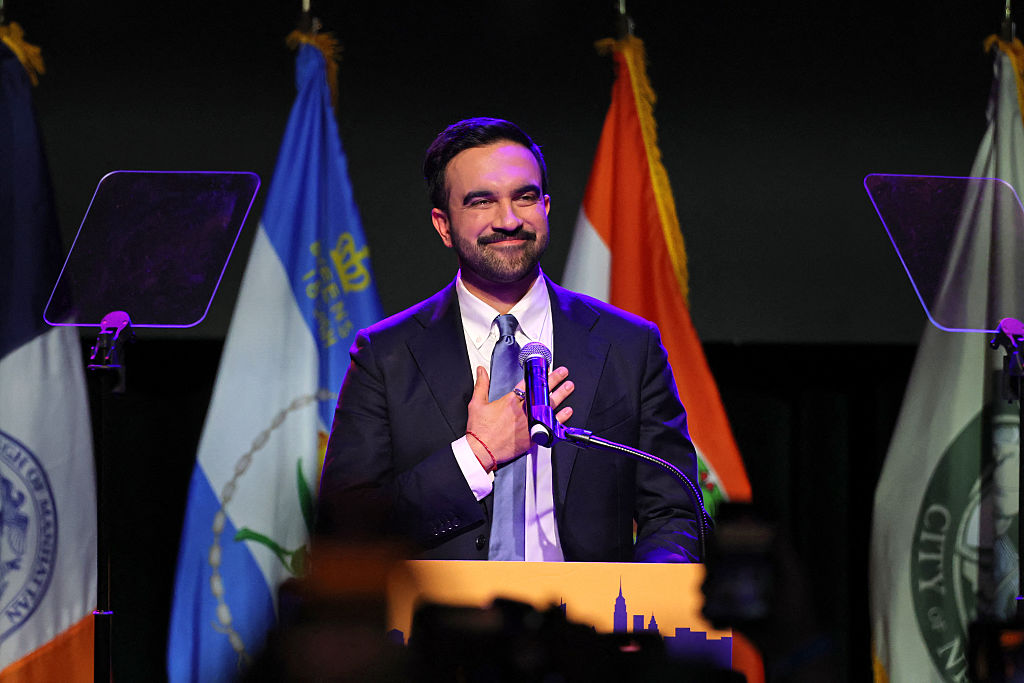Zohran Mamdani’s Win Shows the Promise of Economic Populism
Discontent with the status quo and the political establishment culminated in a perfect storm in New York City, when Zohran Mamdani beat billionaire-backed Andrew Cuomo to become mayor. The win shows how Democrats might beat Trumpism.

In his victory speech, Zohran Mamdani didn’t moderate — he turned the volume up on his populist policy program. (Angela Weiss / AFP via Getty Images)
Zohran Mamdani facing 9/11-themed attacks from Andrew Cuomo’s political machine and criticism from a billionaire at a Saudi conference, and then being elected mayor of New York on the same day Dick Cheney passes — it’s like the final scene of a drama about this entire era. And yet it wasn’t a Hollywood script; it’s what just happened.
Mamdani long ago cast his campaign as something more than a race to run one city. He told the Lever that “this is the heart of the battle for the future of the Democratic Party.” It’s a theme he’s continued to amplify throughout the campaign — and the battle he identified has been on full display over the last week.
On one side are the party’s long-standing luminaries, politicians, media elites, and operatives still clinging to the dream of a return to pre-MAGA normalcy. Many in this faction spent Election Day valorizing Cheney. Others were insisting that to win elections and face down Donald Trump’s authoritarianism, Democrats should construct a big tent that avoids any unifying national agenda at all, periodically try to out-Republican the Republicans on some social issues, and then label that incoherence “centrism.”
On the other side of the divide are Democratic voters, who, according to polls, are more enraged at their party’s leaders than they ever have been, and for good reason. After years of being told that Democratic politicians simply cannot do anything, even when those politicians have power, Democratic voters watched Republicans use that same power to do whatever MAGA wants — and they’ve watched Democratic leaders do all but nothing to stop the GOP rampage.
All of the discontent culminated in a perfect storm in New York City — the capital of global finance, where one in four residents lives in poverty and one in twenty-four residents is a millionaire. An anti-oligarch message targeting the affordability crisis was bound to resonate in such Dickensian conditions, but it could only reach enough voters because of the city’s clean election system, which provides grassroots candidates with enough public money to run competitive campaigns.
In the hands of the charismatic Mamdani, those public resources were shrewdly deployed against the Democratic Party machine and its preferred candidate: a disgraced billionaire-funded nepo baby sex pest who only a few years prior delivered a get-out-of-jail-free card to his health care industry donors amid a pandemic massacre.
In prior years, when Democratic voters were more satisfied with their leaders, the machine might have won the race for Cuomo. But not this time around.
In his victory speech, Mamdani didn’t moderate — he turned the volume up on his populist policy program and reiterated his pledge to combat the master plan that has legalized so much corruption in our politics.
Pundits, politicians, and oligarchs shaken by his victory will no doubt soothe themselves by pointing to conservative Democratic candidates’ victories in New Jersey and Virginia as alleged proof that nothing is fundamentally changing inside the party. But even those milquetoast candidates felt compelled to channel Mamdani-esque economic populism during the final weeks of the election when they feared a loss was on the horizon.
So where does this all go from here? I’m not quite sure, but it seems like the first day of the rest of our political lives, which is probably why I’m experiencing a bit of déjà vu. To me, this era seems vaguely similar to a moment in 2007 — a time when the crimes and corruption of a second-term Republican presidency were demoralizing and enraging the country every day, and Democratic leaders looked similarly dazed, confused, and complicit.
Back then, I published a book called The Uprising, which posited that the growing anger at the status quo would not dissipate. I argued that it would instead be channeled into either a center-left New Deal–esque movement or a far-right reaction — and my youthful optimism prompted my high hopes that it would be the former, not the latter.
But soon after, the nascent progressive form of populism was funneled by Barack Obama into support for the Democratic Party establishment, and conservative populism was plugged into the Tea Party movement. When, amid the financial crisis, Democrats turned expectations of hope and change into more of the same, the Tea Party was able to foment a backlash birthing MAGA, the Trump presidency, and a societal meltdown that continues to this day.
If Democrats repeat that cautionary tale — if they do not deliver on their promises and their liberal fans excuse their inaction — then this moment of possibility will be fleeting, sowing even more disillusionment and further reducing Americans’ dwindling faith in democracy. And clearly, there remain powerful Democratic politicians, media voices, and donors still pining to go back to brunch, still trying to prevent any kind of systemic change inside their party.
But if Democrats actually learn from the cautionary tale a generation ago, if they reorient their party back to New Deal–style populism and genuinely combat the corporations and billionaires ruining everyone’s lives, then this moment of discontent across the country could have staying power — and be a positive force. This could be the beginning of a much more constructive uprising, one that names oligarchy as the enemy, materially benefits the working class, and pulls America back from the brink.
I cannot predict which path Democratic politicians will pick. But I do know most of them are followers, not leaders — which means the choice isn’t theirs. It’s ours.